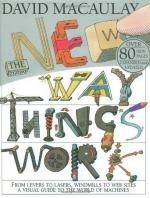
|
| Name: _________________________ | Period: ___________________ |
This test consists of 15 multiple choice questions and 5 short answer questions.
Multiple Choice Questions
1. What is the absence of any light?
(a) White.
(b) Purple.
(c) Black.
(d) Yellow.
2. What is white light?
(a) A combination of the three colors that make up all light.
(b) A light wave that vibrates higher than the colors that make up light.
(c) An inversed reflection of one color of the light spectrum.
(d) An absence of any light.
3. Why is the mammoth at first overjoyed?
(a) He thinks there are other mammoths around.
(b) He has lots of rich alfalfa to eat.
(c) He sees his mother.
(d) He finds a field of clover.
4. What is a core of wire wound around an iron core?
(a) A bushing coil.
(b) A demagnitizer.
(c) An electromagnet.
(d) An altimeter.
5. How do mirrors reflect an image?
(a) As if it were a concave lens.
(b) As if it were a convex lens.
(c) Without distortion.
(d) Inversed.
6. How are positive and negative electrons similar to positive and negative poles?
(a) They both contain anodized matter.
(b) They both contain a neutral charge.
(c) There are no similarities.
(d) The both attract the opposite.
7. In the illustration of binary code, what represents the "off" number?
(a) An empty crate.
(b) A lemon in a crate.
(c) A basketball in a crate.
(d) A pumpkin in a crate.
8. How can bits be saved on tapes?
(a) By transforming them into a magnetic field.
(b) Bits cannot be stored on tapes.
(c) By overwriting the data onto strips.
(d) By impressing the data into dots.
9. Where are the stacked crates taken in an illustration in Chapter 4?
(a) A kitchen.
(b) A marketplace.
(c) A dump yard.
(d) A transport container.
10. How can information in binary code be communicated?
(a) Light waves.
(b) Electrical pulses.
(c) Morse code.
(d) It cannot be communicated.
11. What is another term for electromagnetic waves?
(a) Links.
(b) Rays.
(c) Quantums.
(d) Quarks.
12. If you put a copper wire and a zinc wire into a lemon, what occurs?
(a) A bonding of the zinc to the copper.
(b) A chemical reaction.
(c) A fusing of the zinc to the lemon.
(d) A fusing of the copper to the lemon.
13. How do oppositely charged electrons respond to each other?
(a) Nothing.
(b) They absorb each other and become neutral.
(c) They attract each other.
(d) They repel each other.
14. What happens when visible rays cross the lens of our eye and are bent through the convex surface?
(a) They vibrate the iris.
(b) The can burn out the cortex.
(c) They form an image on the retina.
(d) They vibrate the retina.
15. What does RADAR use?
(a) Radiation.
(b) Radio waves.
(c) Restored particles.
(d) Recharged particles.
Short Answer Questions
1. What two elements combine to make a body scanner?
2. How are signals and messages created out of light and radio waves?
3. Why does Bill invite the mammoth in?
4. What type of storage does RAM offer?
5. What does the frequency of sound waves create?
|
This section contains 510 words (approx. 2 pages at 300 words per page) |

|




